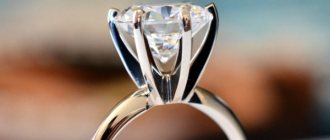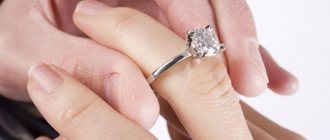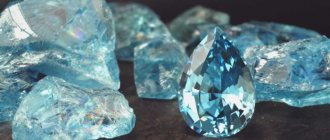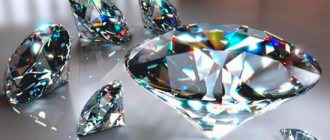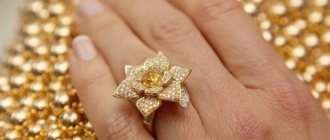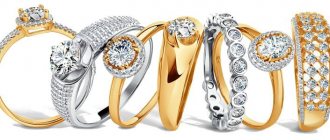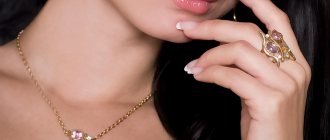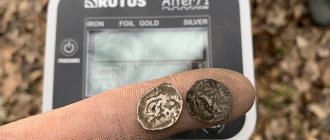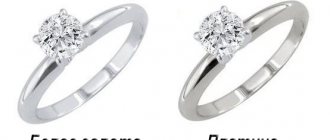“It remains unharmed in the strongest fire, it is the light of the sun, condensed in the earth and cooled by time, it plays with all colors, but itself remains transparent, like a drop of water...” These words were written long before the well-known phrase of Marilyn Monroe, but they do not lose relevance even today.
Needless to say, every woman would like to have diamond jewelry. The price of products with precious minerals, and primarily with cut diamonds, largely depends on the quality of the stone. Therefore, it is very important to be able to correctly decipher the characteristics indicated on the product tag.
Assessment systems
For a long time, there was no classification to evaluate the clarity of diamonds. But since the 50s of the last century, employees of the Gemological Institute of America (GIA) took up this issue closely and created the 4C grading system, which is still the basic one.
According to the new system, the characteristics that determine the value of the gem were assessed:
- diamond clarity;
- color;
- weight;
- cut.
Specialized institutions and certified specialists have the right to evaluate.
The most authoritative are:
- Supreme Diamond Council of Belgium;
- World Jewelry Confederation (Switzerland).
In our country, the Gemological Center of Moscow State University is considered the main appraiser.
Watch the video with interesting facts and tips on choosing a stone:
Diamond grading system: 4 “C”
When conducting an expert assessment of a stone, a gemologist takes into account 4 mandatory criteria, called the 4 “Cs”.
The first parameter is carat weight (stone weight). As you know, the generally accepted measure of the mass of jewelry stones is a carat, equal to 0.2 grams. The word “carat” itself comes from the name of the pod tree, the seeds of which were originally used to measure minerals.
The second is color. To a layman, diamonds appear completely transparent, but in fact their shades vary.
The third parameter is clarity. The purity of a mineral is determined by the presence of inclusions in its composition, as well as their characteristics.
The fourth parameter is cut—the cut of the diamond.
It is these indicators that are the basis for determining the quality of the diamond and, accordingly, the cost of the entire product. And now first things first.
Diamond certificate
A GIA certificate can confirm the authenticity of a gem. Stones for evaluation are delivered anonymously, without information about the owner. After the procedure, a document is issued with a full description of all the characteristics of the gem and an indication of its value. Each copy is assigned an individual alphanumeric number, which reflects all parameters.
Diamonds are graded unbiased by the Gemological Institute of America, making the results 100% reliable.
The certificate must be kept in a place inaccessible to unauthorized people.
Checking the tag on the decoration
Let's start with the fact that when purchasing diamond jewelry, you need to carefully read the tag on the product. The main document certifying the authenticity of a diamond (as, indeed, the declared characteristics of any other stone) is the tag accompanying the jewelry from the manufacturer.
The tag is a certificate for the set stones, containing all the necessary information. The list of details on the jewelry label is regulated by the Industry Standard (OST 117-3-002-95).
How to determine the clarity of a diamond
Flaws on a gem may be visible upon normal inspection without special equipment. To accurately evaluate a diamond, use a 10x magnification loupe. Only the stone is evaluated, without a frame.
After inspection, the gem is assigned to a particular class or group, according to the diamond purity scale.
What is diamond clarity?
Natural diamonds, created by nature, almost always contain coal or snow inclusions in their structure. The presence of inclusions is due to impurities, which also affect the color characteristics.
It is believed that perfect crystals do not exist in nature. Specimens with surface inclusions can be considered ideal. Such diamonds are polished or high-quality cut, thereby removing any defects.
The purity of the diamond depends on the number of inclusions, their location, and extent. That. The clarity of a diamond will be considered good if the stone contains a minimum number of small inclusions.
Victoria will tell you what cleanliness is:
Russian scale
The best quality is for diamonds of the first category, which do not have any defects. There are very few of them, estimated at millions of dollars. When classifying according to the Russian scale, the mass and number of faces are taken into account.
Classification by groups:
GIA Score
The GIA classification takes into account the characteristics of internal defects only. And superficial ones can be removed during processing. The best diamonds are considered to be IF - without inclusions. But they are rare. All classes are suitable for purchase except I 1, I 2, I 3.
Classification:
| Designation | Class | Characteristic |
| Internally Flawless | IF | Ideal, no inclusions. |
| Very Very Small Inclusions | VVS 1 VVS 2 | There are less than 3 very, very small light inclusions. |
| Very Small Inclusions | VS 1 VS 2 | Up to 3 dark very small inclusions or up to 6 light ones. |
| Small Inclusions | SI 1 SI 2 SI 3 | Up to 8 small inclusions. |
| Imperfect | I 1 I 2 I 3 | Large multiple inclusions, cracks. |
Rappoport scale
To determine the market value, the Gemological Institute of America regularly creates the Rappoport scale, based on the current price list. One page displays prices for round diamonds, and the second page displays prices for other shapes.
Prices are updated every 2 weeks. Therefore, for ease of calculation, online calculators have been created.
Correspondence of purity scale indicators
The table shows the relationship between the Russian scale and the GIA scale.
Gems from groups 1–6 have jewelry value. The rest are classified as technical and used in industry.
Now you are ready!
These are all the main nuances that you need to pay attention to when choosing gold or silver jewelry with diamonds. Our sales consultants will always be happy to tell you about the manufacturer of diamond jewelry, and also describe in detail the characteristics of each stone. And commodity experts in the Rossyuvelirtorg network always carefully select the best suppliers of diamond jewelry.
We invite you to familiarize yourself with the presented assortment of diamond jewelry in the catalog of the Rossyuvelirtorg online store. Choose diamond jewelry wisely and delight yourself and your loved ones with precious gifts for many years to come!
Share:
What determines the color of the stone
Color and shade depend on the chemical composition of the mineral:
- the blue tint is created by boron impurities;
- the green color comes from thorium and uranium;
- black - thanks to graphite;
- yellow, brown – nitrogen;
- the pink tint occurs from exposure to high temperatures.
Saturation depends not only on the absence of foreign inclusions, but also on the characteristics of the crystal lattice. A more saturated color is found in those stones that have a dense crystal lattice with a small distance between carbon molecules.
Russian scale
In Russia, diamonds are divided into types based on color using 3 grading scales.
Table for stones with 17 faces:
| Group | Description |
| 1 | White, barely bluish tint |
| 2 | Slight yellowish tint |
| 3 | White with visible color tint or yellow |
| 4 | Brown |
Table for stones with 57 facets weighing up to 0.299 carats:
| Group | Description |
| 1 | White, barely bluish tint |
| 2, 3 | Slight yellowish tint |
| 4 | White with visible color tint |
| 5 | Yellow |
| 6, 7 | Brown |
Table for stones with 57 facets weighing from 0.300 carats:
| Group | Description |
| 1 | Bluish white color |
| 2, 3 | With an almost invisible tint |
| 4, 5 | With barely noticeable yellowness |
| 6, 7 | With a distinct shade |
| 8 | Yellow |
| 9 | Brown |
GIA Score
The GIA rating system provides 2 scales:
- for colorless;
- for colored (fancy) diamonds.
The sample is compared to a diamond standard and assigned a letter designation from D to Z, where D is colorless and Z is yellow. A yellowish tint begins to appear from the letter K.
Colored diamonds are valued according to the principle: the darker, the more expensive.
Correlation of color scale indicators
The table shows how the color scales relate to each other.
What color can a diamond be?
Initially, according to historical data, the first diamonds and diamonds appreciated by the public and jewelers were colorless or transparent.
Over time, fantasy designs began to gain great popularity. That is, pure, rare, hard and beautiful stones, which were an order of magnitude different from their white counterparts.
Firstly, they have great charm. Secondly, their diversity simply defies imagination. Thirdly, they allow you to perfectly combine jewelry frames not only with white gold and platinum, but also with regular yellow. Take, for example, a unique work of art - the famous Tiffany diamond, which only two girls were honored to wear in their lives, and only for a short time.
The main colors in addition to classic transparent diamonds are as follows:
- light yellow and yellow;
- light brown and amber-honey;
- dark brown and black;
- purple (they are now the rarest, mined from deposits in the relatively recently discovered Argyle mine in Australia);
- gray and silver;
- champagne colored stones;
- white specimens;
- bluish and blue;
- lemon and tea petals;
- various other options.
Decoding tags
The tag displays the main parameters: the number of stones, their shape, weight, number of facets, color and clarity classes.
Clearly shown in the image:
If possible, it is better to choose a diamond without visually detectable defects. If flaws are visible on crystals up to 0.300 carats, then their purity is 5, 6 or more. If flaws are visible on stones over 0.300 carats, then the purity is 7, 8 or more.
You can find the designations 2/2, 2/3, 3/3, 4/4, 4/5, 5/5, etc. on the tag - these numbers mean color (first digit) and purity (second digit).
- The 1/1 diamond is considered the most ideal; it is extremely rare and incredibly expensive. Next to it is specimen 2/2, which has very minor defects visible only under a magnifying glass.
- Samples with the designations 3/3, 4/4, 6/6 are more popular among the population and are purchased most often. Defects are not visible without a magnifying glass.
- Gemstones with a clarity of 3 to 6 are considered the most investment grade. Their prices remain approximately the same.
- For those who are limited in funds, option 6/6 is suitable - this is the solution, because the stone looks quite decent, but is not too expensive.
By color it is better to choose F, G, H according to GIA.
Learn more about evaluating a diamond and determining its characteristics in the video:
What to consider when buying diamonds
If funds allow, it is better to choose a specimen without visually visible defects.
For models with 57 facets, the third category is considered good clarity for a diamond; for 17-facets, the second or third category is suitable. According to GIA this means F, G and H.
The best-selling stones are those whose color and clarity correspond to levels 3/3, 4/4, 6/6. Round specimens larger than a carat with a purity of 3–6 are considered investment grade. They never become cheaper and their resale value decreases little.
Silver ring with diamond
The location of the defect is important. If it is on the “platform”, the shine and play of light are minimal. Small cracks or similar flaws at the edge are not important: they will be hidden by the frame of the product.
A precious gem of purity level 4 does not have the conflict of basic parameters inherent in pure stones.
If you need a decent-looking diamond, but have limited funds, it is better to purchase a large 6/6 stone. In terms of quality, it belongs to the average group, but successfully imitates a higher level. The differences are only noticeable under a 10x magnifying glass.
This is the most sought after jewelry insert in Europe.
Color or purity: which is more important?
When choosing jewelry, both characteristics are important, but which one to focus on is determined individually:
- You need to choose according to purity if you intend to have a frame made of yellow gold. It will absorb yellowish shades, thereby brightening the crystal. If the gem is of poor quality, it will appear dirty.
- You need to focus on color if you intend to have a white frame. If the stone has additional shades, a white frame will enhance them. This product will look cheap.
Buy gems from reputable jewelry stores to avoid fraud. Please review supporting documentation before purchasing.
Were you previously familiar with diamond grading scales? Share your experience. Share the article with your friends on social networks. All the best.
What is a quality certificate
A certificate is a document that directly confirms the true quality of a diamond. It contains the following information:
- diamond clarity designation;
- the presence of deficiencies and their number;
- internal arrangement of foreign elements of the mineral.
Many companies involved in the jewelry business have the right to issue a certificate for jewelry. However, there are a couple of laboratories whose assessment meets the highest standards. Both of them are based in America. This:
- Gemological Institute.
- Jewelers Association.
Buying a precious stone is an infrequent event in the lives of ordinary people, and therefore it must be done carefully and carefully. If it is not possible to invite a specialist with you to the jewelry store to help determine the clarity of the stone, you can do this yourself. Knowing the characteristics of real diamonds and the rules for assessing their main parameter - the presence of impurities, it will not be difficult to find out the condition of the jewelry, and therefore the money on it will not be wasted.
What are the best cut diamonds?
This is the main one, but it is not the only indicator that affects the cost of the stone and its appearance.
The way the jeweler cuts it is also important: the number of edges, their symmetry, polishing. A well-executed cut reveals all the beauty and charm of the gem, because it determines how the light will be refracted inside it.
To understand which diamond cut is better, you need to understand the types of stone processing and the difference between them. There is a so-called commercial (B, C) and ideal cut (A). The difference is that when using a commercial diamond processing method, attention is paid not to ideal proportions, but to less loss of weight and size of the gem. Therefore, the entire diamond may have an irregular shape or only a separate part of it.
The ideal cut focuses on correct proportions, symmetry, and neglects loss of weight and size. But, in turn, this increases the cost of a product with a perfectly cut gem. If you look at it from above, you can see the squares, which, intersecting, form the platform (upper part) and arrows. Stones with cut B and C do not have such a clear picture when viewed from above and from the side.
It becomes obvious which diamond is the best: the one that has a high degree of clarity and an ideal cut. But the cost of such stones will be high and not affordable for everyone. It is believed that the lighter the diamond, the more ideally shaped it should be, and vice versa, on dark ones, errors in the proportions of the facets are not so noticeable.
The parameter that determines the size of a gem is its diameter. Its weight and cut proportions also affect the carat value. Nowadays, the weight of one metric carat is 200 mg. It is impossible to give a single answer to the question of which carats of diamonds are better, because the carat does not affect the quality of the gem, but only its cost: the higher the carat value, the more expensive its price will be.
Purchase authentication technology
In pawnshops, precious stones are valued using the 4C system. Initially, the specialist weighs the gem and thus determines its size in carats. After this, using the correspondence table, the sample under study is correlated with the color scale.
Fancy and completely transparent crystals are considered the most expensive. Choosing a color category is far from an easy task. Initially, the appraiser examines the mineral visually and then subjects it to multiple magnifications.
To give a correct assessment, only tools that do not give glare into the depth of the product are used. Lighting fixtures should emit white, and instruments should only be gray or black.
At the next stage, the specialist determines the purity category. After this, he needs to assess the quality of the cut, how accurately and skillfully it was made. If a mineral is poorly processed, you can even notice it with the naked eye. All other flaws can only be seen with magnification. This also makes assessment much more difficult.
Where are diamonds sold?
A prestigious place for selling stones is auctions like Sotheby's. But only the best diamonds are sold here.
Ordinary consumers choose from the following options:
- specialized salon or online store;
- representative .
If you are accustomed to shopping in online stores, it is advisable to choose diamonds from two or three. View the range, read reviews.
The level of the usual salon (offline) is indicated by the conditions created for the buyer:
- There is a place where you can calmly, without prying eyes, evaluate a stone before purchasing. Including using special tools: 10x magnifying glass, carat scales, etc.
- The client is not required to know how to use these devices. At his request, a sales consultant or in-house jeweler will do this. Education and qualifications of personnel will be a plus.
- There are tables with a breakdown of the main characteristics of the stone.
Buying second hand is possible if you are confident in the person’s honesty. But a stone certificate is required.
Which cleanliness should I choose?
Friends and clients always want advice. Here he is! When choosing a diamond, you need to take into account that clarity parameters can be divided into 2 categories. The first is that there are no defects or do not in any way affect the visual perception or appearance of the stone. The second is defects that are noticeable or affect the game, shine and shade. It depends on their size and location. Even a diamond with SI2 and I1 clarity can look great due to the fact that the defects are located in the peripheral zone. In this case, the entire central part of the stone will be clean, and it can be assessed as suitable for purchase. Average performance guarantees a perfect look and a good price.
IF up to VVS2 - ideal performance
VS1 VS2 - excellent performance
- Diamond 0.10 color 3 clarity 5
6 885 ₽
- Diamond 0.30 K/VS1
30 600 ₽
- Diamond 0.5 carat cut circle G SI1
99 450 ₽
Diamond 1 carat round J SI1
374 850 ₽
Diamond 2 carats emerald cut GIA E VVS2
2 524 500 ₽

